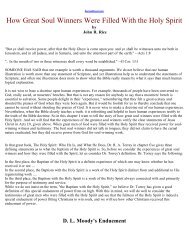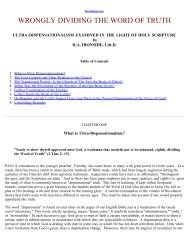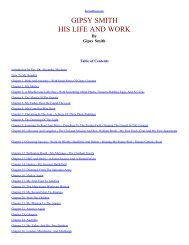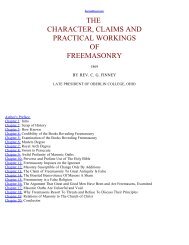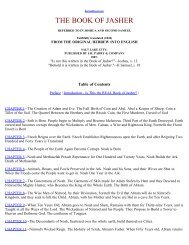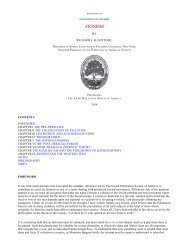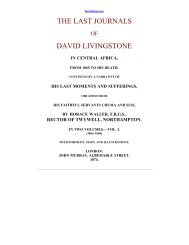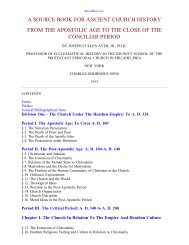Legends of Babylon and Egypt in Relation to Hebrew Tradition.pdf
Legends of Babylon and Egypt in Relation to Hebrew Tradition.pdf
Legends of Babylon and Egypt in Relation to Hebrew Tradition.pdf
You also want an ePaper? Increase the reach of your titles
YUMPU automatically turns print PDFs into web optimized ePapers that Google loves.
evidence <strong>of</strong> a subsequent attempt <strong>to</strong> comb<strong>in</strong>e with these more ancient traditions the cont<strong>in</strong>ued religious dom<strong>in</strong>ance <strong>of</strong><br />
Marduk <strong>and</strong> <strong>of</strong> <strong>Babylon</strong>.<br />
Our conclusion, that the Sumerian form <strong>of</strong> the tradition did not die out, leaves the question as <strong>to</strong> the periods dur<strong>in</strong>g<br />
which <strong>Babylon</strong>ian <strong>in</strong>fluence may have acted upon <strong>Hebrew</strong> tradition <strong>in</strong> great measure unaffected; <strong>and</strong> we may therefore<br />
postpone its further consideration <strong>to</strong> the next lecture. To-day the only question that rema<strong>in</strong>s <strong>to</strong> be considered concerns<br />
the effect <strong>of</strong> our new evidence upon the wider problem <strong>of</strong> Deluge s<strong>to</strong>ries as a whole. What light does it throw on the<br />
general character <strong>of</strong> Deluge s<strong>to</strong>ries <strong>and</strong> their suggested <strong>Egypt</strong>ian orig<strong>in</strong>?<br />
One th<strong>in</strong>g that strikes me forcibly <strong>in</strong> read<strong>in</strong>g this early text is the complete absence <strong>of</strong> any trace or <strong>in</strong>dication <strong>of</strong><br />
astrological /motif/. It is true that Ziusudu sacrifices <strong>to</strong> the Sun-god; but the episode is <strong>in</strong>herent <strong>in</strong> the s<strong>to</strong>ry, the<br />
appearance <strong>of</strong> the Sun after the s<strong>to</strong>rm follow<strong>in</strong>g the natural sequence <strong>of</strong> events <strong>and</strong> furnish<strong>in</strong>g assurance <strong>to</strong> the k<strong>in</strong>g <strong>of</strong><br />
his eventual survival. To identify the worshipper with his god <strong>and</strong> <strong>to</strong> transfer Ziusudu's material craft <strong>to</strong> the heavens is<br />
surely without justification from the simple narrative. We have here no pro<strong>to</strong>type <strong>of</strong> Ra sail<strong>in</strong>g the heavenly ocean.<br />
And the destructive flood itself is not only <strong>of</strong> an equally material <strong>and</strong> mundane character, but is <strong>in</strong> complete harmony<br />
with its <strong>Babylon</strong>ian sett<strong>in</strong>g.<br />
In the matter <strong>of</strong> floods the Tigris <strong>and</strong> Euphrates present a strik<strong>in</strong>g contrast <strong>to</strong> the Nile. It is true that the life-blood <strong>of</strong><br />
each country is its river-water, but the conditions <strong>of</strong> its use are very different, <strong>and</strong> <strong>in</strong> Mesopotamia it becomes a curse<br />
when out <strong>of</strong> control. In both countries the river-water must be used for matur<strong>in</strong>g the crops. But while the ra<strong>in</strong>s <strong>of</strong><br />
Abyss<strong>in</strong>ia cause the Nile <strong>to</strong> rise between August <strong>and</strong> Oc<strong>to</strong>ber, thus secur<strong>in</strong>g both summer <strong>and</strong> w<strong>in</strong>ter crops, the<br />
melt<strong>in</strong>g snows <strong>of</strong> Armenia <strong>and</strong> the Taurus flood the Mesopotamian rivers between March <strong>and</strong> May. In <strong>Egypt</strong> the Nile<br />
flood is gentle; it is never abrupt, <strong>and</strong> the river gives ample warn<strong>in</strong>g <strong>of</strong> its rise <strong>and</strong> fall. It conta<strong>in</strong>s just enough<br />
sediment <strong>to</strong> enrich the l<strong>and</strong> without chok<strong>in</strong>g the canals; <strong>and</strong> the water, after fill<strong>in</strong>g its his<strong>to</strong>ric bas<strong>in</strong>s, may when<br />
necessary be discharged <strong>in</strong><strong>to</strong> the fall<strong>in</strong>g river <strong>in</strong> November. Thus <strong>Egypt</strong> receives a full <strong>and</strong> regular supply <strong>of</strong> water,<br />
<strong>and</strong> there is no difficulty <strong>in</strong> dispos<strong>in</strong>g <strong>of</strong> any surplus. The growth <strong>in</strong> such a country <strong>of</strong> a legend <strong>of</strong> world-wide<br />
destruction by flood is <strong>in</strong>conceivable.<br />
In Mesopotamia, on the other h<strong>and</strong>, the floods, which come <strong>to</strong>o late for the w<strong>in</strong>ter crops, are followed by the ra<strong>in</strong>less<br />
summer months; <strong>and</strong> not only must the flood-water be controlled, but some portion <strong>of</strong> it must be deta<strong>in</strong>ed artificially,<br />
if it is <strong>to</strong> be <strong>of</strong> use dur<strong>in</strong>g the burn<strong>in</strong>g months <strong>of</strong> July, August, <strong>and</strong> September, when the rivers are at their lowest.<br />
Moreover, heavy ra<strong>in</strong> <strong>in</strong> April <strong>and</strong> a warm south w<strong>in</strong>d melt<strong>in</strong>g the snow <strong>in</strong> the hills may br<strong>in</strong>g down such floods that<br />
the channels cannot conta<strong>in</strong> them; the dams are then breached <strong>and</strong> the country is laid waste. Here there is first <strong>to</strong>o<br />
much water <strong>and</strong> then <strong>to</strong>o little.<br />
The great danger from flood <strong>in</strong> <strong>Babylon</strong>ia, both <strong>in</strong> its range <strong>of</strong> action <strong>and</strong> <strong>in</strong> its destructive effect, is due <strong>to</strong> the<br />
strangely flat character <strong>of</strong> the Tigris <strong>and</strong> Euphrates delta.[1] Hence after a severe breach <strong>in</strong> the Tigris or Euphrates, the<br />
river after <strong>in</strong>undat<strong>in</strong>g the country may make itself a new channel miles away from the old one. To mitigate the danger,<br />
the floods may be dealt with <strong>in</strong> two ways--by a multiplication <strong>of</strong> canals <strong>to</strong> spread the water, <strong>and</strong> by provid<strong>in</strong>g escapes<br />
for it <strong>in</strong><strong>to</strong> depressions <strong>in</strong> the surround<strong>in</strong>g desert, which <strong>in</strong> their turn become centres <strong>of</strong> fertility. Both methods were<br />
employed <strong>in</strong> antiquity; <strong>and</strong> it may be added that <strong>in</strong> any scheme for the future prosperity <strong>of</strong> the country they must be<br />
employed aga<strong>in</strong>, <strong>of</strong> course with the <strong>in</strong>creased efficiency <strong>of</strong> modern apparatus.[2] But while the <strong>Babylon</strong>ians succeeded<br />
<strong>in</strong> controll<strong>in</strong>g the Euphrates, the Tigris was never really tamed,[3] <strong>and</strong> whenever it burst its right bank the southern<br />
pla<strong>in</strong>s were devastated. We could not have more suitable soil for the growth <strong>of</strong> a Deluge s<strong>to</strong>ry.<br />
[1] Baghdad, though 300 miles by crow-fly from the sea <strong>and</strong> 500 by river, is only 120 ft. above sea-level.<br />
[2] The <strong>Babylon</strong>ians controlled the Euphrates, <strong>and</strong> at the same time provided aga<strong>in</strong>st its time <strong>of</strong> "low supply", by<br />
escapes <strong>in</strong><strong>to</strong> two depressions <strong>in</strong> the western desert <strong>to</strong> the NW. <strong>of</strong> <strong>Babylon</strong>, known <strong>to</strong>-day as the Habbânîyah <strong>and</strong> Abu<br />
Dîs depressions, which lie S. <strong>of</strong> the modern <strong>to</strong>wn <strong>of</strong> Ramâdi <strong>and</strong> N. <strong>of</strong> Kerbela. That these depressions were actually<br />
used as reservoirs <strong>in</strong> antiquity is proved by the presence along their edges <strong>of</strong> thick beds <strong>of</strong> Euphrates shells. In addition<br />
<strong>to</strong> canals <strong>and</strong> escapes, the <strong>Babylon</strong>ian system <strong>in</strong>cluded well-constructed dikes protected by brushwood. By cutt<strong>in</strong>g an<br />
eight-mile channel through a low hill between the Habbânîyah <strong>and</strong> Abu Dîs depressions <strong>and</strong> by build<strong>in</strong>g a short dam<br />
50 ft. high across the latter's narrow outlet, Sir William Willcocks estimates that a reservoir could be obta<strong>in</strong>ed hold<strong>in</strong>g



